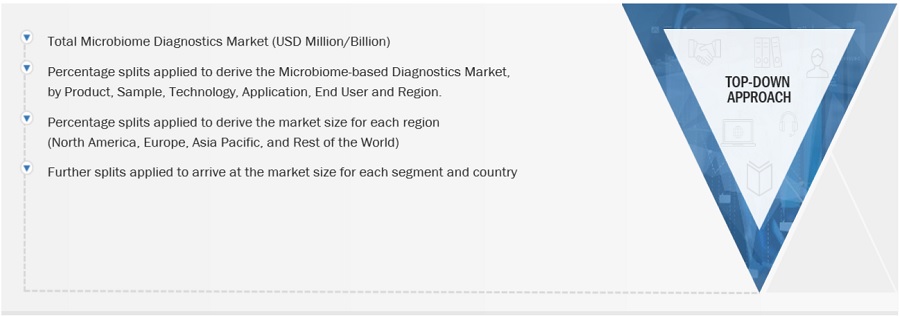The objective of the study is to analyze the key market dynamics such as drivers, opportunities, challenges, restraints, and key player strategies. To track companies’ developments such as product launches and approvals, expansions, and partnerships of the leading players, the competitive landscape of the microbiome diagnostic market to analyze market players on various parameters within the broad categories of business and product strategy. Top-down and bottom-up approaches were used to estimate the market size. To estimate the market size of segments and subsegments, the market breakdown and data triangulation were used.
The four steps involved in estimating the market size are
Collecting Secondary Data
The secondary research data collection process involves the usage of secondary sources, directories, databases (such as Bloomberg Businessweek, Factiva, and D&B), annual reports, investor presentations, and SEC filings of companies. Secondary research was used to identify and collect information useful for the extensive, technical, market-oriented, and commercial study of the microbiome-based diagnostics market. A database of the key industry leaders was also prepared using secondary research.
Collecting Primary Data
The primary research data was collected after acquiring knowledge about the microbiome diagnostics market scenario through secondary research. A significant number of primary interviews were conducted with stakeholders from both the demand side (such as doctors, nurses, and hospital purchase managers) and supply side (such as included various industry experts, such as Directors, Chief X Officers (CXOs), Vice Presidents (VPs) from business development, marketing and product development teams, product manufacturers, wholesalers, channel partners, and distributors) across major countries of North America, Europe, Asia Pacific, Rest of the World. Approximately 40% of the primary interviews were conducted with stakeholders from the demand side while those from the supply side accounted for the remaining 60%. Primary data for this report was collected through questionnaires, emails, and telephonic interviews.
A breakdown of the primary respondents is provided below:
Breakdown of Primary Participants:

Note 1: Others include sales managers, marketing managers, and product managers.
Note 2: Tiers are defined based on a company’s total revenue. As of 2022: Tier 1 = >USD 1 billion, Tier 2 = USD 500 million to USD 1 billion, and Tier 3 <USD 500 million.
To know about the assumptions considered for the study, download the pdf brochure
|
COMPANY NAME
|
DESIGNATION
|
|
DNA Genotek (US)
|
Manager
|
|
Viome Life Sciences (US)
|
VP Sales
|
|
Genetic Analysis AS (Norway)
|
Regional Sales Head
|
|
Becton, Dickinson and Company (US)
|
Sales Director
|
Market Size Estimation
All major product manufacturers offering various microbiome diagnostics were identified at the global/regional level. Revenue mapping was done for the major players and was extrapolated to arrive at the global market value of each type of segment. The market value microbiome-based diagnostics market was also split into various segments and subsegments at the region and country level based on:
-
Product mapping of various manufacturers for each type of microbiome diagnostics products at the regional and country level
-
Relative adoption pattern of each product type among key application segments at the regional and/or country-level
-
Detailed primary research to gather qualitative and quantitative information related to segments and subsegments at the regional and/or country level.
-
Detailed secondary research to gauge the prevailing market trends at the regional and/or country-level
Global Microbiome Diagnostics Market Size: Bottom Up Approach

To know about the assumptions considered for the study, Request for Free Sample Report
Global Microbiome Diagnostics Market Size: Top-Down Approach

Data Triangulation
After arriving at the overall market size—using the market size estimation processes—the market was split into several segments and subsegments. To complete the overall market engineering process and arrive at the exact statistics of each market segment and subsegment, the data triangulation, and market breakdown procedures were employed, wherever applicable. The data was triangulated by studying various factors and trends from both the demand and supply sides in the microbiome-based diagnostics industry.
Market Definition
Microbiom diagnostic products are used to investigate and understand the complex communities of microorganisms living in and on the human body. Microbiome diagnostics involves collecting samples from various body sites, such as the skin, gut, mouth, and other mucosal surfaces, and analyzing the genetic material such as DNA, RNA of the microorganisms within these samples.
Key Stakeholders
-
Manufacturers and distributors of microbiome-based diagnostics products
-
Pharmaceutical and Biotechnology Companies
-
R & D centers
-
Diagnostic laboratories
-
Hospitals and clinics
-
Academic institutes
-
Research institutes
-
Market research and consulting firms
Report Objectives
-
To define, describe, segment, and forecast the global microbiome diagnostics market by product, sample, application, end user and region.
-
To provide detailed information regarding the major factors influencing the market growth (such as drivers, restraints, opportunities, challenges, and trends)
-
To analyze the micromarkets1 with respect to individual growth trends, prospects, and contributions to the overall microbiome diagnostics market
-
To analyze market opportunities for stakeholders and provide details of the competitive landscape for key players
-
To forecast the size of the market segments with respect to four regions, namely, North America, Europe, the Asia Pacific, and the Rest of the World
-
To profile the key players and comprehensively analyze their product portfolios, market positions, and core competencies2
-
To benchmark players within the market using the proprietary Competitive Leadership Mapping framework, which analyzes market players on various parameters within the broad categories of business and product excellence
Available Customizations
With the given market data, MarketsandMarkets offers customizations as per the company’s specific needs. The following customization options are available for this report:
Geographic Analysis
-
Further breakdown of the microbiome-based diagnostics market into specific countries/regions in the Rest of Europe, Rest of Asia Pacific, and Rest of the World.
Company Information
-
Detailed analysis and profiling of additional market players (up to 3)



Growth opportunities and latent adjacency in Microbiome Diagnostics Market